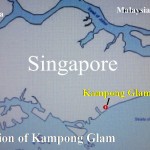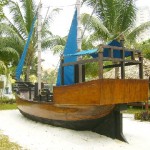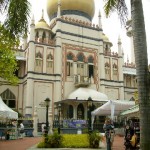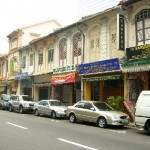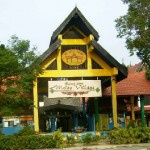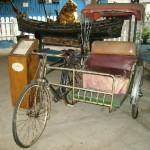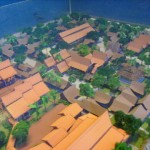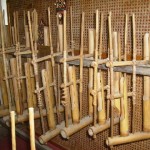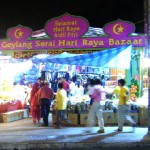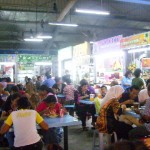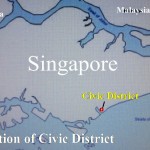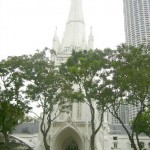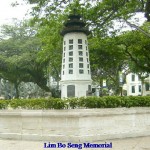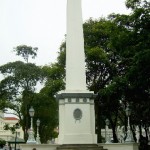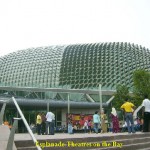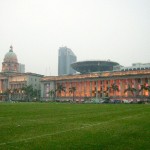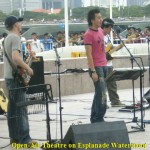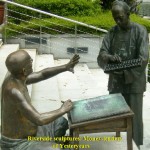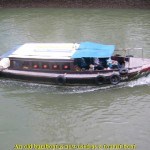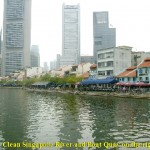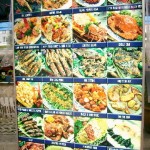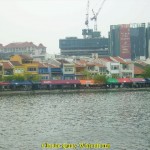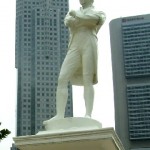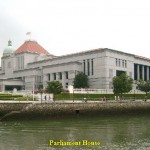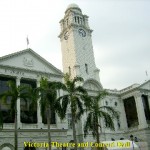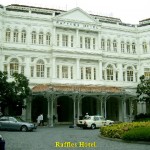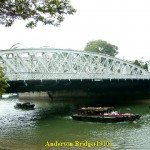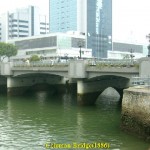Singapore Heritage Trail II
Filed under: Singapore Heritage Trail II (Malay Heritage & Civic District)
(continued from Singapore Heritage Trail I)
Singapore Travel II
(Malay Heritage and Civic District)
3. Malay Heritage
To learn about the Malay heritage, I visited two places, viz. Kampong Glam and Geylang Serai.
Kampong Glam
Located at the mouth of the Rochor River, Kampong Glam was originally a Malay fishing village. It is named after a tree by the Malays. Its scientific name is melaleuca leucapan, a large tree that is used for making poles, posts, boats and other things.
In the past, Kampong Glam was a centre of Islamic Studies where the aspiring Muslims from neighbouring countries would prepare themselves for the pilgrimage to Mecca. Those who failed to make it were called “Haji Singapura“.
Kampong Glam was the first Malay settlement in Singapore designated by Sir Stamford Raffles in 1820’s. Sultan Ali Iskandar Shah built a two storey Palladian architecture-styled palace, Istana Kampong Glam, in 1840’s. It was believed that George Colemen designed the palace. It is located at the end of the road named Sultan Gate.
Istana Kampong Glam or Istana Sultan(Sultan Palace)
Istana Kampong Glam or Istana Sultan is now a museum showcasing the history and cultures of Malay and Bugis in Singapore. The Bugis were brave seafarers from the southern Sulawesi Island of Indonesia. They played a vital role in the Malay Sultanate’s politics by the 18th. Century. Some were appointed as viceroys and married into the Malay royalty.
The museum houses several galleries such as the history and cultures of the Singapore’s Malays, Bugis seafarers, Malay royalty, Malay entertainment industry, and many more. Below are some of the photos taken at the Istana Kampong Glam (museum):
Sultan Mosque
Built in 1824 near Bussorah Street was Sultan Mosque. It was built by Sultan Hussein Shah with donations from Sir Stamford Raffles and the East India Company. In 1924-1928, the mosque was rebuilt to replace the old one. It is the largest mosque in Singapore. The local Muslims consider it to be the grand national mosque in Singapore. It has a large golden dome that is easily seen from far.
In front of the mosque is Bussorah Street where the old, quaint two-storey shophouses sell souvenirs, apparels, curios, postcards, traditional Malay cuisine, artefacts, handicrafts, etc.
Arab Street
In the early years, the Arab immigrants set up shops along Arab Street. The area around Arab Street, Baghdad Street and Bussorah Street was once a cultural and historical centre of Islamic life. Many quaint and restored buildings still remain in this area. They are now shops which sell Islamic things such as skull caps and prayer rugs, carpets from the Middle East, traditional batiks from Malaysia and Indonesia, textiles and other goods from Japan, Korea and Europe. Jewellery, artefacts, handicraft and furniture are also sold here.
Geylang Serai
Having visited the Istana Kampong Glam museum, I went to another museum, Malay Village or Malay Heritage Centre, in Geylang Serai, to learn more about the Malay heritage. To go there, I took an MRT train to the Payar Lebar Station. Then I walked a short distance to Geylang Serai where the indigenous Malays have lived since 1840’s.
Malay Village (The Malay Heritage Centre)
Tthe Malay Village covers an area of 2.2 hectares which was opened in a grand style in 1996. It is truly built like a Malay village with its entrance in a shape of a horn-roofed Minangkabau structure.
The Malay Village showcases all aspects of the Malay culture and tradition in Singapore such as kampong life in the 1950s-60s, musical instruments, bridal chambers, house or thatched house on stilts, weapons, arts, handicrafts, fishing equipment, famous Malay singers, prominent Malay political leaders and more.
Below are some of the photos taken at the Malay Village featuring the Malay culture:
More photos of the Malay culture below:
At the Malay Village, there are Malay kampong shops selling souvenirs, traditional herbs, batiks, baju kurung etc. and an open-air food court where Malay delicacies are served, such as sizzling grilled meat and noodle soup with shredded chicken meat.
Geylang Serai Bazaar and Market.
As it was the Muslims’ fasting month of Ramadan in 2006, the streets in Geylang Serai were decorated with coloured bulbs, arches and objects in the shapes of a crescent moon and star. When night fell, the whole place was brightly-lit and streets were crowded with people. In fact, there was an atmosphere of festivity then. Some local Muslims could be seen breaking fast at food-stalls at the Geylang Serai Market or bazaars while others busy shopping for new shoes, clothes, artificial flowers, cookies and other things for the birth of the new moon of Syawal or Hari Raya Puasa.
4. Civic District
On the following day, I took an MRT train to the City Hall MRT station to visit the Civic District in the city centre. It is one of the tourists’ favourite destinations in Singapore. It is located at the mouth of Singapore River and on the northern bank of the river stretching from the river mouth to a few km inland. This district is rich in history. There are many historical landmarks which are the legacies of the British colonial rule in this area.
When I was in the Civic District, I tried to visit as many landmarks as I could, including those mentioned below:
St. Andrew’s Cathedral
As I was walking along St. Andrew Road for a short distance from the City Hall MRT station, I saw the first historical building. It was a majestic, white church built in the early English Gothic style. It has spires of over 60 metres tall.
The church is known as St. Andrew’s Cathedral and is the Singapore’s oldest Anglican church. Indian convict labour was used to build it between 1856 and 1864 replacing the old one which was damaged by lightning twice. The damaged old church was rebuilt in 1834-1837.
In the colonial days, the church was mostly patronized by the elite. Walking inside the large nave of the church, I could see many plagues on the walls that were dedicated to important people in the past. This church was gazetted a monument in 1973.
Monuments
a. Civilian War Memorial
While walking to Stamford Road, I saw four identical columns of about 70 metres tall standing close to each other in a garden. They were erected in dedication to the civilians of the four main races (Chinese, Malay, Indian and others) who were killed during the Japanese Occupation in Singapore (1942-1945). An urn containing the ashes of unknown victims is placed in the middle of this simple but sombre monument that is known as Civilian War Memorial. Leaving the civilian war monument, I walked towards south and came across more monuments. Below are some of them:
b. Tan Kim Seng Fountain
This Victorian cast-iron fountain was built by the Municipal Council in 1882 to commemorate a well-known trader and philanthropist, Tan Kim Seng, who had contributed much to the well-being of the society. He had made a large donation to the Singapore Waterworks to alleviate the water problem in the city.
c. The Cenotaph
This tower-like structure was erected in 1922 in memory of those who perished in World War I (1914-1918) and it is also dedicated to those fallen soldiers in World War II (1941-1945).
d. Lim Bo Seng Memorial
This pagoda-like structure with four bronze lions standing in guard was built in 1954 in memory of a Singaporean hero, Lim Bo Seng. He led Force 136, an anti-Japanese resistance movement, in World War II. In 1944 he was captured by the Japanese in Malaya. The latter tortured him to death as he refused to reveal his fellow resistance fighters. After the war, he was buried in Singapore with full military honours.
f. The Dalhousie Obelisk
This tall pointed stone pillar was erected to commemorate the visit of Governor-General of India, Lord Marquis Dalhousie, and his wife in 1850 when Singapore was a thriving port. The local rich merchants donated money to build that structure in the hope that his visit would lead to great improvements in public works, amenities and the administration of Singapore. Later, they were disappointed as nothing concrete materialized from their wish.
City Hall
Later, I walked to a road, Connaught Drive, where I could see across a green field (locally known as “Padang”) two large old stately buildings with Corinthian columns standing next to each other. The one with a green dome is the Supreme Court whereas the other the City Hall.
Built in 1929, the City Hall was formerly known as the Municipal Building. It was renamed as City Hall in 1951 when Singapore was conferred city status by King George VI of Englnd. This building will become a national art gallery by 2010 as part of the civic and cultural district.
Supreme Court
Supreme Court was built in 1937-1939 next to the City Hall. It was the former courthouse of the Singapore’s Supreme Court. On 20 June 2005, the Supreme Court was moved to a new building just behind it. The old building is planned to become an arts and cultural centre in future.
New Supreme Court
The new supreme court in sharp contrast to the old one, architecturally. It is modern in appearance. Built of steel, aluminium and glass, it has 9-storeys of 12 civil courts, 8 criminal courts and 3 appellant courts. Resting on top of the Supreme Court is a circular structure of 66m in diameter that looks like a flying saucer. It houses the court of appeal and has a public observation gallery where one can have a panoramic view of the Singapore River.
“Padang”
In front of the City Hall is a large green field which the local people call it “Padang”. It was here that the European civilians were ordered to gather and marched to Changi Prison, immediately, after the surrender of Singapore in 1941. Then four years later on 12 September 1945, ironically, the Japanese officers were made to march pass the “Padang” to City Hall where they surrendered, unconditionally.
Esplanade-Theatres on the Bay
Later, I walked towards east to Esplanade-Theatres on the Bay. Located on a six-hectare waterfront land by the Marina Bay and near the mouth of Singapore River, it was officially opened on 12 October 2002. It consists of two prominent and unique buildings which look like a thorny tropical fruit called “durian”. One of them houses the 1,600-seat Concert Hall and the other 2,000-seat Theatre. It is a performing arts and entertainment centre which boasts of world-class performances by local and international groups.
Besides, there is an open-air theatre on the 300-metres long waterfront outside the Esplanade. Free outdoor musical performances are held there on weekends.
Modern Buildings
As I was standing on the waterfront, I looked across the Singapore River and saw a spectacular view of several
awesome, tall and modern buildings, including UOB Plaza, UOB Centre, Sinsov Building, Maybank Tower, HSBC, OCBC Building and Capital Square. Some of these tall buildings are over 60 storeys high. They are in the central business district (CBD). The existence of these skyscrapers is a testament to Singapore’s fast growing economy in trade, commerce and finance.
Fullerton Hotel
The skyscrapers on the bank of Singapore River tower over a quaint but majestic building known as Fullerton Hotel. The building was first occupied by Singapore Club and Chamber of Commerce, then General Post Office and Inland Revenue Authority. Now it is a well-known five-star hotel.
Built in a neo-classic styled architecture in 1928, the hotel was voted the best hotel in Asia at the conde’ Nast Traveler Reader’s Choice Awards 2006 held recently in New York.
Merlion
When I was crossing the Esplanade Bridge over Singapore River, I saw a strange large white stone legendary animal. Located at the Merlion Park in front of Fullerton Hotel and the mouth of Singapore River, it has a head of a lion and scaly body of a fish. Its fish body is to remind people that Singapore was a fishing village before and its lion head tells the people that the nation gets its name from the Malay word “singa” which means “lion”. The Singaporean call this mythical animal “Merlion”. It is now Singapore’s icon. This animal keep on spouting water out of its mouth into the Marina Bay.
Riverside Sculptures
Strolling on the river bank, I came across some life-sized bronze sculptures seemingly involved in some activities in the olden days, such as a group of naked and playful children leaping into the Singapore River.
(Installed in 2000 and known as “The First Generation”), colonial trader, Chinese merchant, coolies, Indian money-lender (chettiar), financier, etc.
A unique modern sculpture of a large black fat bird by Fernando Botero was erected in 2000 at the back of the tall UOB building. It is a symbol of peace, serenity, joy of living and the power of optimism.
Singapore River : A Maritime Trading Hub
Singapore River is over 11 km long and flows through the city. It was once a lifeline of Singapore. During the British colonial rule, the port was at the river mouth. When Sir Stamford Raffles declared it a free port, trade flourished. More shophouses and warehouses were built at Boat Quay, Clarke Quay and other places along the river to cope with the increase in trade. Soon the river became the hub of trade, commerce and finance.
As trade had increased by leaps and bounds, larger and more ports were needed. Large terminals and harbours were built at other places to take over the maritime trading activities of the old port, such as Keppel Harbour, Jurong, Pasir Panjang and Sembawang. By the 1980’s, the river-mouth port ceased its operation.
Since wastes from residential, industrial and farm areas had flowed into the river for many years, it became smelly and dirty. In 1977, the government began to clean up the river. It took ten years to complete the task. Now the river is clean and has a pleasant sight. Speedboats and tourists’ cruise boats (bumboats) can now be seen plying on the clean river.
Bumboats
In the yesteryears, bumboats were used to carry goods to and from along the Singapore River between ships moored in the busy port at the river-mouth and warehouses at Boat Quay, Clarke Quay and other places inland. Since the trading activities in the river ceased many years ago, the bumboats are now used for carrying tourists for the river cruise.
Boat Quay and Clarke Quay
Boat Quay and Clarke Quay were important trading places along Singapore River in the olden days. When maritime trading activities stopped at the port at the river-mouth, these quays had to change their trading services.
Today, Boat Quay and Clarke Quay are food-lovers’ haunts. The quaint and clean shophouses and wharehouses are now used as restaurants, wine bars, chill-out places and entertainment hotspots. Besides, there are al fresco pups and restaurants by the river. Delicious local and exotic cuisines are served here. Singapore’s popular dishes, chili and pepper crabs, are available here. Both places are good for families and friends to wine and dine together as the places are rich in Singapore history.
Sir Stamford Raffles
Walking down the riverside, I came across a pure-white polymarble statue of a smartly-dressed man folding his arms and standing on a high pedestal. He was Sir Thomas Stamford Raffles who founded Singapore in 1819. The statue marks the site where the man and his 120 Indian assistants and soldiers landed on 28 January 1819. It was erected in 1972.
Asian Civilizations Museum
A beautiful majestic white building near the white statue of Sir Stamford Raffles is the Empress Place. It was a government office built by convicts in 1864-1867. Now it is a museum known as Asian Civilizations Museum which was officially opened in 2003. It houses several galleries including Singapore River Gallery, Southeast Asia Galleries, West Asia/Islamic Galleries, China Gallery, South Asia Galleries and Japanese Mask Gallery. On display are over 1,300 artefacts spanning 5,000 years of Asian cultures from China, India, South-east Asia, to West Asia.
I have visited the museum and feel that it is an excellent place to gain knowledge of the ancient civilizations, cultures, religions, economies, etc. in the Asian regions.
The Arts House
Behind the Asian Civilizations Museum is the oldest government building in the city. This grand mansion was built by George Coleman in 1827. Originally, it was used as a residence. Later it became the Court House and then the Assembly House of the colonial government. When Singapore gained her independence in 1965, it became the nation’s Parliament House. Then in 1999. the Parliament was moved to a new building nearby.
Now, the old Parliament House is known as ” The Arts House” where one can attend or see contemporary visual arts, music, dance, film, comedy and performances by local and international artists.
Siamese King’s Visit
In front of the Arts House is a dark bronze elephant statue standing on a tall white pedestal. It was erected to commemorate the first visit to Singapore made by a Siamese king, Somdech Phraparamindr Mahachulalonkorn, on 16 March 1871.
Victoria Theatre and Concert Hall
Not far from the Arts House is another beautiful colonial building of Neo-Classical architecture, with rusticated columns and Italianate windows. The building which is known as Victoria Theatre was first erected in 1862 as Singapore’s Town Hall.
In 1905, another building, Victoria Memorial Hall, was built next to the first one to commemorate the long and glorious reign of Queen Victoria of England (1837-1901). Then in 1909, a 45m clock tower was erected in between the two buildings linking them as one. In 1979, the Memorial Hall was renamed Victoria Concert Hall. Today, it houses the Singapore Symphony Orchestra and holds both local and international performances.
In front of the beautiful building stands a dark bronze statue of Sir Stamford Raffles, the founder of Singapore. In 1887, it was first erected at the Padang and in 1909 it was moved to the present place.
Raffles Hotel
As I walked back to the City Hall MRT station, I visited one of the 19th. century world’s most famous hotels, Raffles Hotel. Originally, the hotel was an old bungalow. Later it was rebuilt and expanded. It has been popular among tourists and famous people. The hotel is now considered as the grand dame of Singapore’s hotels.
Historic Bridges
In the Civic District, there are several old and historic bridges spanning across River Singapore which was once the island’s hub of busy trading and commercial activities. A few examples of these bridges are shown in the photos below:
Conclusion
I am glad to have visited the four heritage places in Singapore, viz. Chinatown, Little India, Kampong Glam-Malay Village and the Civic District, as I have learned so much about their histories, traditions, cultures, religions, diverse peoples and landmarks. Besides, I understand now the reasons my grandfather and father left China and came to Singapore, and the kind of life they both had in Singapore in the late 1930’s and early 1940’s.
That is all about my Singapore heritage trail. I hope the information given above is still useful to you.
The End
Written by Choo Chaw, Kluang, Johor, Malaysia

